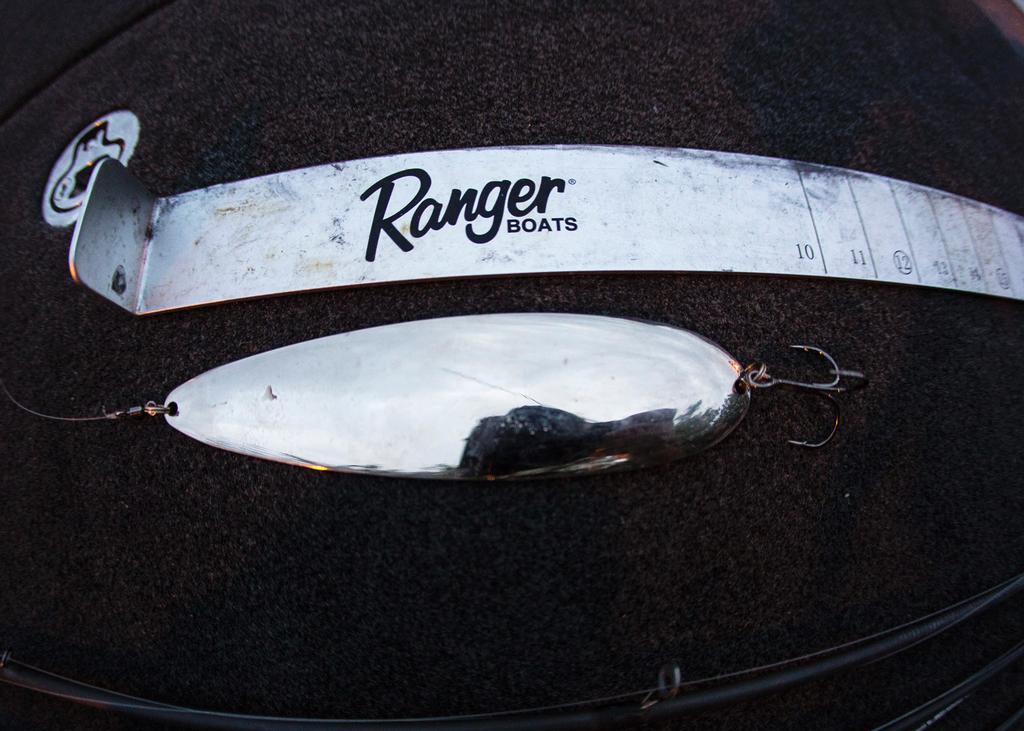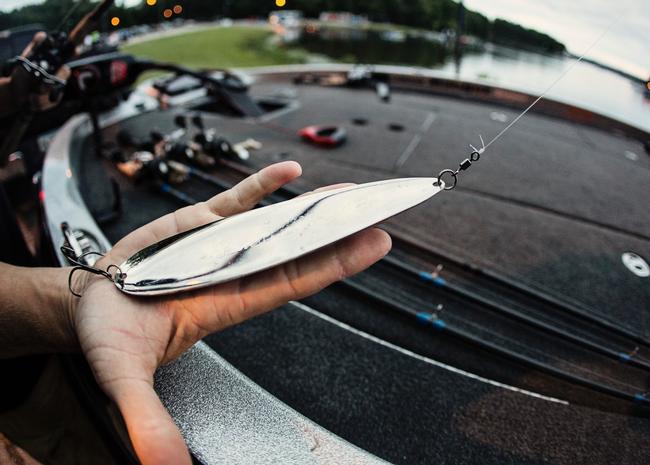Magnum Spoons Land on Kentucky Lake

There are very few secrets in ledge fishing, and Kentucky Lake seems to be the place where most ledge secrets get broadcast to the world.
At the final Walmart FLW Tour stop of 2014, which enters its third day of competition this morning on Kentucky Lake, the best ledge-fishing pros in the business have revealed the next must-have lure for offshore fishing: the Magnum Spoon.
You’ve seen the “big spoon,” which was unleashed to the world in a bass fishing TV show filmed on Kentucky Lake a few years ago. But the new Ben Parker Signature Series Magnum Spoon makes the old one look like a baby spoon.
At almost 8 inches long, 2 inches wide and about 3 1/2 ounces, the Magnum Spoon, which was created by professional bass angler Ben Parker, looks more like it belongs on a saltwater rig or tied to the line of a Northern muskie hunter than factoring into a bass tournament in Tennessee.
Yet, there’s been plenty of buzz – both literal and figurative – about the spoon this week.
Several top 20 pros have been using it. Others might be using it but not talking. One caught all his fish on it Thursday and Friday. Another is relying on it to pluck his biggest kickers each day. And as of now, it seems that none of them had the spoon prior to practice.
Pros who don’t have a Magnum Spoon are quite literally begging their competition for a spare. A few anglers have been snapping photos with cellphones to show off the size – this thing dwarfs an ordinary Coke can.
As for the literal buzz, that’s the sound the Magnum Spoon makes when it’s launched in the air. It swirls and spins like a propeller, sounding off with an eerie whirl.
Pickwick guide and Tennessee River expert Jason Lambert (currently in seventh place) is among the pros willing to talk about the Magnum Spoon. He’s used it to catch about half the keepers he’s weighed thus far this week.
“I’m not catching a whole bunch of fish on that spoon, but when I do catch one, it’s going for a ride to weigh-in,” he says. “I can’t get bit on a regular spoon.”
According to Lambert, who’s good friends with Parker and occasionally works with him on guide trips on the Tennessee River, the spoon has been in various prototype stages for several months.
“The first time it was thrown was at the [B.A.S.S.] Open tournament on Douglas,” Lambert says. “As of the Friday before the Kentucky Lake tournament, there were only two of them. But then he made a run of them.
“I heard about it from the Internet, through YouTube, where Ben posted a video,” Lambert adds. “Once it hit the Internet, the bass world started talking about it. All the ledge guys talked about it because we throw spoons a lot.”
Lambert first got his hands on the spoon last Sunday during practice, and it didn’t take but 10 casts to really see its potential as a gorilla hunter.
“It’ll fire them up, but mostly it’s going to catch the biggest fish in the school,” Lambert says.
It’s not just the size of the spoon that makes it a big-bass catcher. Its effectiveness is based on the old fishing strategy of matching the hatch. There’s no other spoon out there that better mimics a big gizzard shad.
“Ben guides out here, and he told a guy he wanted a spoon to imitate those big shad that come up schooling,” Lambert says. “You see those big 6- to 8-inch gizzard shad come up schooling all the time.”
As effective as it has been for the pros that have it, the Magnum Spoon does have a couple of drawbacks. For starters, its size and broad profile make it very difficult to cast, especially in the wind. Lambert says he’s made casts into the wind with it that miss his target by 15 yards.
Its weight is also a burden. Lambert is throwing his on a frog rod. Another pro upsized to a flipping stick. Fishing it requires a heavy rod and a hookset type of swing to rip it off bottom, which is the traditional spoon-fishing technique.
Landing percentages also occasionally suffer, but it’s not necessarily any worse than what anglers experience with a regular-sized spoon.
“I lost a big one on it the first day,” says Lambert, “but that’s just the nature of a spoon.”
There’s no word yet on where and when the spoon will be available to the masses, but if the buzz it creates is anything like the original spoon, there’ll be plenty of tackle makers looking to capitalize on the opportunity while availability is still slim. (Editor's update: Check this more recent story for information on where to buy the Magnum Spoon.)
The Magnum Spoon has already accounted for several top-20 finishes this week. It’s gotten some laughs from the media, some of which thought pros were throwing it as a gag at first. As for how it’ll impact the weekend, now that most of the field has seen or heard of its effectiveness, that’s yet to be seen. At least one more showed up on the deck of a top 20 pro’s boat this morning, and as more pop up and they get passed and shared around, pretty soon everyone will know the truth about the formerly secret Magnum Spoon.
